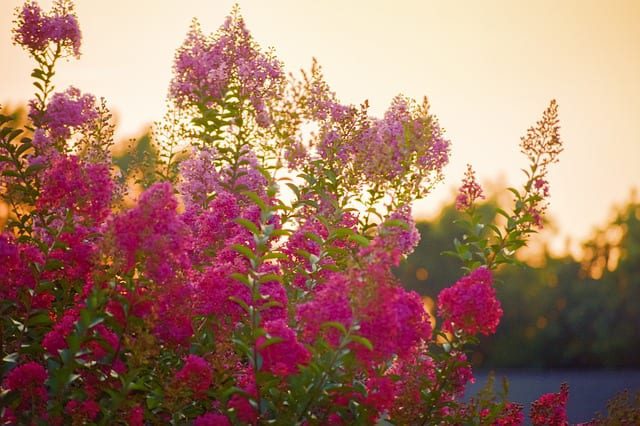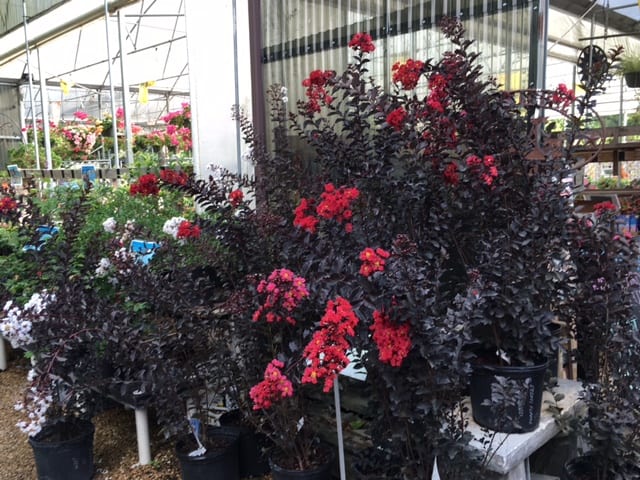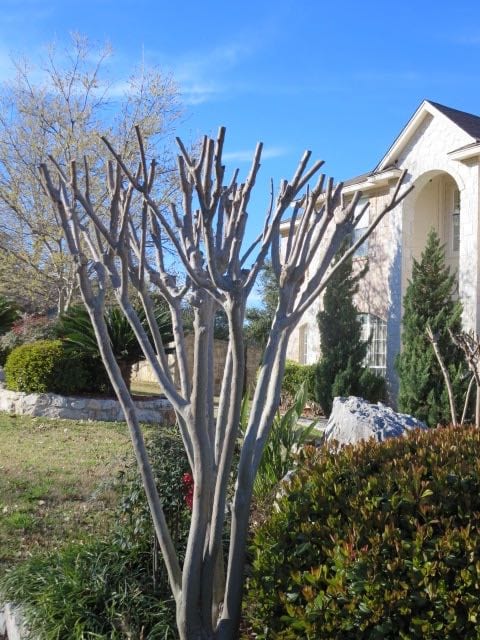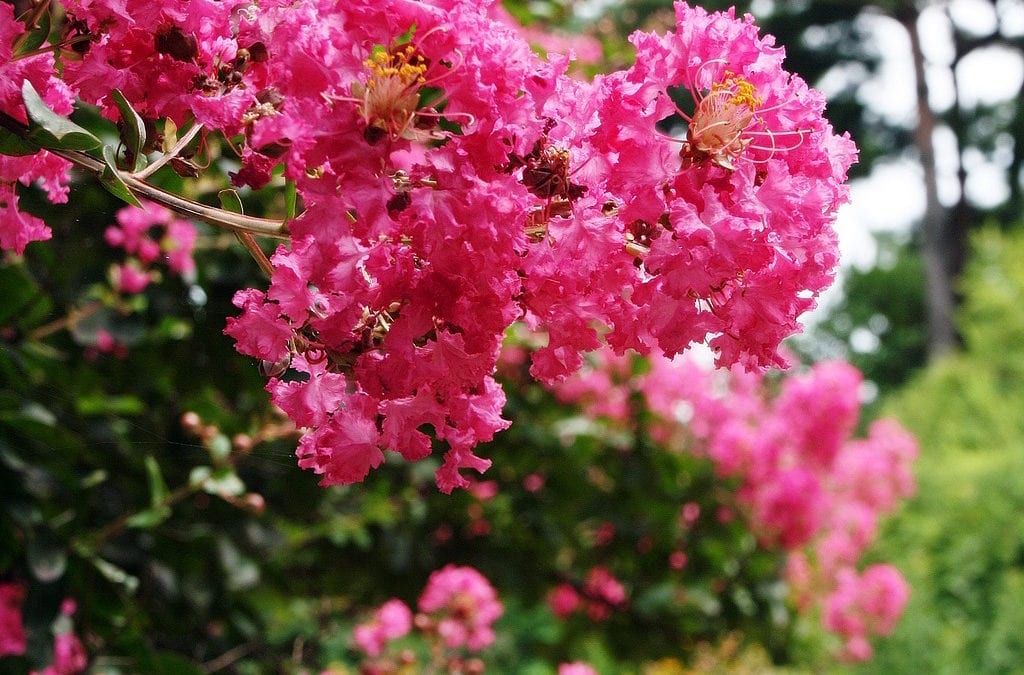Summer is the time when crape myrtles put forth their numerous blooms in full display; so wouldn’t it make sense to choose yours now to make sure you get the exact color you want?
Crape myrtles come in a variety of shades. Try shopping for a red crape myrtle and you may be surprised to hear us ask, “What color of red?” When it comes to crape myrtles, there is no such thing as plain red, or pink, or even plain green foliage for that matter. Crape myrtles vary wildly in color, and size too! Shop for a red crape myrtle and you’ll choose amongst hues of watermelon-red, cherry-red, true-red, and more. Prefer pink? You’ll get to choose from a range of shades that run from magenta to cotton candy pink. It’s hard to distinguish between them if you don’t actually see the blooms. See a few pink selections to the right? Quite a difference in hue.


Foliage can be be green, red, and even ebony (see the picture at right) depending on the variety and time of year. The foliage on some crape myrtles changes color in fall, and all crape myrtles are deciduous, so will lose their leaves through winter.

4 Facts To Remember About Crape Myrtles.
1. Size Matters. When it comes to choosing the correct crape myrtle for your landscape it is imperative that you measure how far you desire the crape myrtle’s mature height and canopy size to expand in your yard. Crape myrtles run the gamut from miniatures, maturing at only 1′-2′ high with a spread of 2′, to towering 20′ trees with a spread of 25′, and everything in between. Get the right size crape myrtle for your landscape needs!
- Stake a post in your landscape where you want to the trunk of your the crape myrtle to be planted.
- Tie a string loosely around the post and while holding the string, walk it out to furthest point you desire the canopy to extend. Walk all around the post so you have a 350° vantage point.
- Research which crape myrtles will fit in those measurements at their mature height, and buy one of those.

You wouldn’t want to plant this massive crape myrtle in a tight corner somewhere in your landscape.

Crape myrtles can also be left in their natural shrub form.
2. Crape myrtles need very little maintenance. Did you read that? Please read it again, then shout it from the rooftops, and definitely into your landscapers’ ears. No more crape murder! There is no need to chop the tops off your crape myrtles. Following the advice from tip #1, buying the correct size crape myrtle in the first place, should eliminate any (false) excuse to cut back your crape myrtles. If a crape myrtle has been severely butchered, it’s possible to cut it all the way down and start over if needed. See this article from Neil Sperry that describes this technique.
There are only 3 real reasons to prune certain parts of crape myrtle:
- To remove branches that are growing sideways and rubbing against trunks.
- To train your crape myrtle into a tree by removing extra trunks down to the ground. It’s recommended to keep 3 or more trunks when training into a tree (odds look best.)
- To remove the brown capsules on the distal areas of branches once flowers have completed their bloom in order to promote a new flush of blooms about 30-40 days after pruning. Just prune the spent flower heads, not the entire branch. (These should not be removed after September.)

Stop crape murder! It creates knobby trunks and spindly, weak branches, and is completely uneccessary if you plant the right sized crape myrtle for your needs.

Young sprouts may need to be removed from the base of crape myrtle when training into a tree, especially first few years.

3. Bloom time can vary by 6-8 weeks depending on your variety of crape myrtle. Flower blossoms develop on new growth, so while each variety varies in its exact bloom time, flowering can also depend on the pruning you did in winter. Crape myrtles that have been severely pruned will be more delayed in their blooming process.

4. Crape myrtles are versatile and tolerant of our climate and soils.
Crape myrtles like the heat and humidity, and once they are established (about 2 years), they can handle drought. On the other hand, on those rare occasions we have a deluge of rain for days on end, crape myrtles also handle short periods of flooding. Just remember that shrubs/trees take more water to get established in summertime.
Crape myrtles can also be planted in acidic or alkaline soil, making them comfortable just about anywhere. They prefer full sun for best blooms, and good air circulation helps prevent mildew issues. Buying from Rainbow Gardens also helps as all of our crape myrtle selections are mildew resistant.

Full sun is the best location for your crape myrtles to put on their best blooms.

With such a variety in color, size, and shape, you can see why we think crape myrtles are a choice landscape plant for everyone! Come see us at Rainbow Gardens and let us help you pick out the perfect crape myrtle for you!
~The Happy Gardener


Great article!
I’m trying to find a description of what the different Forms are. I’m guessing they a description of the general, natural shape of the plant, but I don’t know what the differences are between them…especially some like, Globosely, Up Vase, etc. Is there some place I can find this info?
Thanks!
Hi Sandy,
I’m looking myself for info on specific shape, but can’t find a “chart-like” reference. The best reference I’ve got so far is the description in the link in the blog for the varieties. If i find something better, I’ll pass it along.
Crepe Myrtles have now been calculated to be the most common. tree species in urban California, comprising over 6& of all town and city trees in the state..
I have had my crape Myrtle for two winters. It is now about 5 ft tall. Last winter we had an early frost that dropped all the leaves, so I never got to see the fall color of my Natchez Myrtle. This year all the trees in the neighborhood have turned beautiful orange and reds but my Natchez leaves remain dark green. Help
Is your tree green and full of foliage? Or is is sparse? It may just be behind the times from the early frost and be taking longer to turn its foliage color. Or, if it is sparse like the tree featured in this post from Neil Sperry, it may have more sever winter damage. See post and Neil’s advice and let me know if your tree looks like this.
Advice for those whose crape myrtles have been attacked by bugs (?) and now have black branches?
Sounds like aphids have gotten to your crape myrtle and the black branches are most likely the honeydew that they excrete which turns into sooty mold. Is your crape myrtle low enough to be able to blast the branches and entire affected area with a sharp stream of water from the hose? That’s always our first response when it comes to aphids. Insecticidal soap, pyrethrin, etc. can also help to eliminate aphids. We suggest you take a look at our blog, “Common sucking pests in the Garden” for more info on how to deal with aphids.
Great article! I wish I had found this before I got my crepe myrtle. I got a free one for Arbor Day last year from my city, so I’m not sure if it is a tree or a bush. Is there a way to tell before it matures in 5 years?
Can I repot my crape myrtle and put pesticide?
Thanks
Hi Eva,
Yes you can repot you’re crape myrtle. The sooner you can do it the better. What pesticide are you wanting to use and why? Crape myrtles aren’t very susceptible to pest damage, so be sure you are getting the correct product
for what you need.
Good afternoon
I repot my crape myrtles 2 months ago, can I put miracle-gro all purpose plant food every 14 days? And I transplanted 3 crape myrtles in the ground 6 months ago can I put the same fertilizer?
Thank you
Hi Eva,
Yes you can use your Miracle Gro liquid fertilizer to feed your crape myrtles both in the pots and in the ground. If you don’t want to feed as often (every 14 days) you can use a slow release fertilizer like Osmocote (that can feed plants up to 4 months). But if you are fine with feeding every 14 days through spring and summer, Miracle Gro will work. Remember to water your plants well right after fertilizing.
I really appreciate to answer me, thank you very much.
I’m one of those that Crepe Murder every winter. I do have a reason, the stupid builder planted 2 crepes about 2-3 feet from the front of my house. What dumbass plants a tree that close to a house and foundation.🤦♂️
Hi Steve,
Oof, I feel your pain. I, myself, have two Japanese Ligustrum that the builder planted to close to my home as well. It’s a battle each year to keep it contained and the roots are a concern by the foundation!
I have never cut back my crape myrtles since I bought my home here in East Texas 30 years ago. But I only get a couple os blooming flowers each year out of three tall plants. What can I do to help them bloom?
Thomas,
Are your crape myrtles understudy trees in your landscape? Any shade from taller trees blocking them from direct sun? Full sun is a crape myrtle’s best friend.
Have you ever fertilized them? If they are not blooming they could be lacking phosphorous. Check to see if the fertilizer you have been using is high in nitrogen, and then switch to a fertilizer low in nitrogen and high in phospohorus (the middle number on the ratio on the fertilizer bag). Adding some bone meal to the soil around the tree will gradually add the phosphorous you need as well. Then, give it a little time to work as crape myrtles bloom at different times of the year depending on variety. Hope this helps.
Hi! I have a cm that was supposed to be pink… as it grew and started blooming it was half white and half pink. I LOVE IT THAT WAY!! As the years go by the white is taking over it’s no 3/4 white to 1/4 pink. Is there any way to bring back some more of the pink? Thank you.
The only thing I can think of that might have happened is that perhaps another variety of crape myrtle might have been grafted onto the rootstock of your crape myrtle and the rootstock might be taking over the grafted area that might have been damaged at some point and now you have the true crape myrtle growing. How long have you had it? There isn’t a technique to get it back to pink unfortunately.
I planted a Muskogee crape myrtle in the yard and do not plan on pruning the top – I want it to reach its full height. I understand the trees’ flowers only grow on new growth – will it continue to bloom even after it reaches its mature height?
Hi Lavinia,
Yes, your crape myrtle will continue to keep blooming once it reaches its mature height. Pruning is not necessary for blooms.
I am in zone 6 can I wrap my tree for winter? Even tho the company said zone 6
It would be prudent to wrap it, as well as offer it a 3″ layer of mulch around the base of the trunk (but not piled up against it, more in a donut shape around the trunk). It also depends on what variety of crape myrtle you have. Most are cold tolerant to zone 7 which is 0°F, but others may survive your zone 6. Do you know what variety you have? Cold hardiness will also depend on the duration the temps remain below 0°. (The longer, the more risk of damage).
Water well a day or two before freezing temps, and use your winter protection wrap.
Thank you so much.
Absolutely. Thank you for reading.
I have a crape Myrtle shrub that has no buds on it.. it is only two years old. It’s now June and still no flowers? Plenty of sun and leaves are green..Any help??
Hi Ann,
Have you by chances pruned your crape myrtle this year? Crape Myrtles bloom on new wood, so if it got pruned, it’s possible you literally “cut” your chances for the blooms this year. Do you know the variety of crape myrtle that you have? Some bloom earlier or later than others. Have you fed your crape myrtle and if so, did you give it a high nitrogen fertilizer? Too much nitrogen can cause foliage growth but no flowers (offer one with a higher phospohorous number). Inspect leaves closely for signs of aphids or other insects that could cause a bloom shortage.
Hello;
I have a Black Diamond variety of CM that has not grown as quickly as the more common variety I bought (non-Black Diamond). They are both blooming and in full sun, same area, about 10 feet more or less apart, full sun. What can I use to help BD grow as fast as the regular one? Both are healthy except for the growing issue. They are about the same age.
Hi Denise,
By chances did the Black Diamond variety get planted at a different time of year, like spring or summer versus fall? It can take a little longer for roots to get established during hotter weather. I;m curious if it just needs a little time to catch up. You mentioned they are about the same age; what age is that? You could try applying some root stimulator to the BD, watering it in all around the dripline (the area of soil that is under the canopy of the tree, look for the shadow on the ground from where the canopy stretches out and treat that entire area).
Also, keep in mind that “fast growth” is not always the best for trees. They need time to grow healthy and successfully (and it sounds like that’s what they are doing). But, I can understand a frustration if you want a unified look. All crape myrtle varieties have their little growth differences, and it could be as simple as this.
We have an early blooming, white flowered crepe Myrtle. I don’t know the variety name for it. My problem is that it blooms right when the Japanese beetles appear. They consume the flowers and congregate in huge numbers on the tree. Short of spraying, is there anything I can do to get the tree to bloom later (after the beetles have died off)?
Hi Kathy,
You might try using a grub control (product with imidacloprid) to kill off the larvae before they emerge from the soil as adults in June. You can’t really control the blooming period of your crape myrtles, unless you replace it with one that perhaps has a different bloom time. But having one that blooms right when the beetles show up, you will need to be consistent and persistent with your pest control (grub granules, or spraying).
Just planted 2-3 foot high variety of Crepe Myrtle. Should I expect blossoms next summer?
Hi Bob,
As long as your crape myrtles are in full sun, fed, and watered, you should very much expect blooms by summer (or spring/late summer depending on variety).
I have a Sioux Crape Myrtle. I think it is an older CM. Last year, it was severely pruned and bloomed very late with lots of leaves compared to blooms. This was my first year here so I don’t know much history on my Crepe Myrtle. My landscaper did a soil test last year and it needed more phosphorous, so she fertilized it, and told me not prune it this year. This year, it has lots of green leaves and looks healthy, but no blooms at all yet, even though it is nearly July. What else can we do to get it to bloom better? I am in zone 8b.
Hi Mary Beth,
Don’t fret yet! Sioux Crape Myrtles generally have a later bloom time. Late July and all the way through fall is when you should expect your pink blooms to pop! Good that you held off on pruning this year, they really don’t need much. Hold tight… Crape Myrtle fertilizer tends to have a higher phosphorous number which promotes blooms so you should be in good shape. If you don’t see blooms by mid August, we might have to look at another cause. (Is it getting enough water through this drought?)
Thank you Happy Gardner for that information on my Sioux Crepe Myrtle. Yes, we are in a drought right now, but I do have irrigation. I actually saw 1 bloom on my Crepe Myrtle today.
Hooray! So happy you spied a bloom! Thank you very much for your question and I wish you many happy blooms in the future!
I retired last September and have taking up planting flowers and tress as a hobby! I enjoy watching grow of things I’ve planted! Question1?I have several crape myrtles a few is blooming but a few hasn’t! However the foliage is healthy! Do some varieties have different bloom times! Question 2 ! I may be moving to new location!can they live if I dig up and plant in new location and what’s the best process for that? Thanks! Yep
Hi Garry,
YES! Crape Myrtle’s do have different blooming periods depending on their varieties. One of mine just started blooming a week ago and another has yet to flower, different varieties! Do you happen to know what varieties you have? As for transplanting, it is best done in the cooler weather so the plant is not as stressed when it arrives at its new location. November is generally the best time for transplanting and dividing plants. You’ll want to get as much of the root system as you can when you dig it up and try to have the hole somewhat dug at the new place and ready to go, as you don’t want the rootball to dry out. Be careful when transporting that you wrap the tree, rootball and leaves as plants can suffer windburn on the drive, setting them back quite a bit. Follow our tree planting guide and dig your new hole twice as wide and only as deep or slightly shallower than the current top of the soil line of your crape myrtles. Water deeply and offer a little liquid root stimulator. That’s a good start and then keep up with watering to establish your trees in their new location. Hope this helps!
Hello, I guess I am confused. If blooming only happens on new growth and you don’t prune it back, how does it continue to bloom once it is full grown? Is that the end of it flowering?
Hi Richard,
It is more about HOW you prune your crape myrtles. Selective pruning is ok. We are just trying to help spread the word that “topping” crape myrtles, as see a ton of landscaping companies do, is not the proper technique and can weaken the tree. I’m attaching our reasons for pruning a crape myrtle. Hope this helps!
There are only 3 real reasons to prune certain parts of crape myrtle:
To remove branches that are growing sideways and rubbing against trunks.
To train your crape myrtle into a tree by removing extra trunks down to the ground. It’s recommended to keep 3 or more trunks when training into a tree (odds look best.)
To remove the brown capsules on the distal areas of branches once flowers have completed their bloom in order to promote a new flush of blooms about 30-40 days after pruning. Just prune the spent flower heads, not the entire branch. (These should not be removed after September.) Removing dried pods during the winter doesn’t promote any more bloom during the summer. Removing them during the summer may promote faster re-bloom.
Smaller crape myrtles (dwarf, shrub varieties, creeping) can generally take more severe pruning than taller trees.
Bottom line, your crape myrtle will still be producing new growth whether or not you prune, as long as you are keeping it watered and fertilized.
Scroll down through this attached article and you can see an illustration of a crape myrtle properly pruned and one that hasn’t been, along with the results of each.
Thank you so much for posting this! I’ll definitely look for a Crape Myrtles and plant it in my garden.
– Sam (owner of tree removal south bend company)
Have a potted crepe Myrtle bush. Need to know how to handle during the winter
Hi Peggy,
You really shouldn’t have to worry about your Crape Myrtle through winter if you live in San Antonio, as it is hardy down to 10°F. Even being in a pot, it should fare well unless we have prolonged, extended, extreme temperatures as we did a few years ago in winter. In that case, you would need to take regular winter protection measures that can be found here.
Hi, I live in California and moved into a home almost two years ago that has a 20′ Crepe Myrtle with a 5′ span that looks leggy. It gets a lot of foliage but few blooms. I water deeply once a week in the summer due to our high temperature. I have not fed it any fertilizer. What fertilizer do you recommend?
We like Nutristar Crape Myrtle fertilizer by Nelson, or Crape Myrtle fertilizer by Carl Pool.
Thank you so much for your reply. I enjoy your informative site..
I planted a MsFrancis early August. It had flowers to begin with and continued new blooms through mid September. We are very dry here in Dripping Springs, Tx so I have been slow soaking every 3rd day for 3-4 hours. Left town for a week and no more flowers and fewer leaves now, but with new growth at the base of trunk. Is there something else I need to do?
Hi Sandy,
This variety generally blooms late June – August, so having blooms in Septmeber was a bonus. It might just be time for its blooms to be fading out. It sounds like you were doing right by soaking it, and you can continue to do so, especially after being out of town to help it recover from any stress it received while you were gone, although you may extend the time between soaking as we get cooler temps. I would cut off the growth at the base of the tree, those are just suckers that don’t need to be there and compete with the main trunk and roots. You don’t need to add any fertilizer at this time as you want to let the tree start to harden off for winter. Resume fertilization in springtime. A 10-10-10 formula is adequate adn you can fertilize with this every 2-3 weeks an expect some great blooms in summer again.